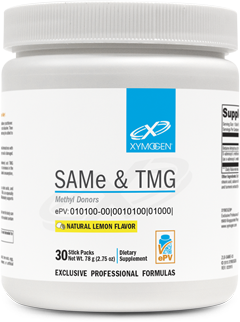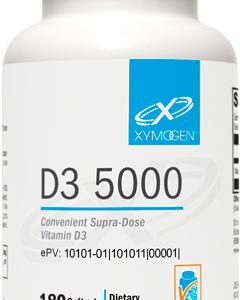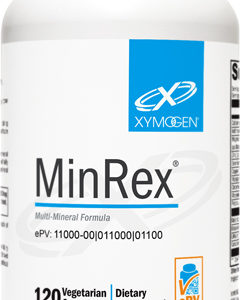Scientific Information/Data
S-adenosyl-L-methionine (SAMe) is a naturally occurring substance formed in the body from the amino acid methionine and the “energy molecule” adenosine triphosphate (ATP). Formation of SAMe is catalyzed by methionine adenosyltransferase and depends on cofactors including vitamin B6, vitamin B12, folate, and magnesium. SAMe has been studied as a supportive nutrient in liver health, joint comfort, metabolic reactions, and healthy mood.*[1-4]
Methylation SAMe is the “universal” methyl donor for biochemical reactions throughout the body.[5] This methyl transfer, or “transmethylation,” is critical to reactions involving proteins, phospholipids, DNA, RNA, creatine, hormones, development of cell membranes, degradation of histamine, and formation of norepinephrine and dopamine. [1,6] Eighty- five percent of transmethylation takes place in the liver, and healthy SAMe levels appear to be essential to liver health and function.*[2,7]
Antioxidant and Liver Support SAMe is considered to be “critical” for synthesis of glutathione, a principal component of antioxidant and detoxification systems in the body.[1] Following donation of a methyl group, SAMe is converted to S adenosyl- homocysteine (SAH). This biochemical reaction promotes the transsulfuration pathway in the liver that generates glutathione. Further metabolism of SAH involves trimethylglycine (TMG), also known as betaine anhydrous. TMG plays an important role in maintaining a healthy SAMe:SAH ratio in the liver.*
During a national symposium, the roles of SAMe and TMG in supporting liver health were reviewed with a focus on their participation in the vital processes of transmethylation and transsulfuration, their ultimate contribution to increased glutathione synthesis and its hepatoprotective effects, their promotion of a balanced SAMe:SAH ratio, their activation of phosphatidylethanolamine methyltransferase, and the increase in phosphatidylcholine synthesis as a result of their administration.[8] Ongoing animal studies suggest that SAMe supports liver health[9,10] and that exogenous SAMe may positively affect cell-life regulation of hepatocytes.[7] In certain human cohorts, researchers recommend further research into combining SAMe with nutrients such as vitamin B6 to optimize outcomes.*[5]
Healthy Mood Supplemental SAMe appears to support a healthy mood, possibly due to its active role in methylation and its involvement in the formation of monoamine neurotransmitters.[3,11-13] Meta-analysis of earlier studies suggested that SAMe showed greater support of a healthy mood when compared to placebo with an effect comparable to that of other treatments.[14] A 30-day, double-blind, placebo-controlled, randomized study of 80 women suggested that there was a significant improvement in mood after the women received an oral dose of 1600 mg/d of SAMe compared to placebo.[15] Another study of 143 subjects who received an oral dose of 1600 mg/d of SAMe suggested that SAMe yielded positive results that were comparable to other treatments for supporting a healthy mood, but SAMe was better tolerated.[16] In a small (N=26), four-week, double-blind, randomized protocol comparing oral SAMe with other treatments, 62% of the SAMe group showed signi cant improvement in mood. The study revealed a signi cant correlation between plasma SAMe levels and the degree of healthy mood support, regardless of treatment type.*[17]
TMG Trimethylglycine is a naturally occurring compound (glycine attached to three methyl groups) that is found in food (estimated intake 0.5-2 g/d) and can be produced in the body from the precursor choline.[18] TMG is thought to protect liver cells, support homocysteine metabolism and cardiovascular health, and may also support a healthy mood due to its role in SAMe metabolism.[3,9,18,19] When TMG donates a single methyl group, it is converted to dimethylglycine (DMG), which is capable of donating two methyl groups. TMG is thought to stimulate activity of the enzyme betaine-homocysteine methyltransferase (BHMT). BHMT, found in abundance in a healthy liver,[20,21] is used by TMG to donate a methyl group to homocysteine. Once TMG adds a methyl group to homocysteine to produce methionine, the methionine can then be converted to SAMe.
A randomized, double-blind, crossover study of healthy volunteers suggested that TMG supplementation (at doses of 3 g and 6 g/d) has a dose-dependent effect on serum TMG levels and a signi cantly positive effect on maintaining healthy homocysteine levels.[22] Together, SAMe and TMG provide an abundant source of methyl groups and ultimately support a wide variety of biochemical reactions in the body.*
SAM-e XYMOGEN’s SAM-e contains a minimum of 70% of the SS isomer of SAMe, the form the body can use most readily. This relatively high concentration from Gnosis’ Adomix® not only makes SAM-e particularly bioavailable but also cost-effective. Each capsule is sealed in a nitrogen-purged blister pack to maximize protection from the environment.*
*These statements have not been evaluated by the Food and Drug Administration. This product is not intended to diagnose, treat, cure, or prevent any disease.
References
1. Natural Standard Database. SAMe. http://naturalstandard.com/databases/ herbssupplements/same.asp?#unde ned. Accessed October 21, 2012.
2. Friedel HA, Goa KL, Ben eld P. S-adenosyl-L-methionine. A review of its pharmacological properties and therapeutic potential in liver dysfunction and affective disorders in relation to its physiological role in cell metabolism. Drugs. 1989 Sep;38(3):389-416. [PMID: 2680435]
3. Papakostas GI, Cassiello CF, Iovieno N. Folates and s-adenosylmethionine for major depressive disorder. Can J Psychiatry. 2012 Jul;57(7):406-13. [PMID: 22762295]
4. Mayo Clinic. SAMe. Updated September 1, 2012. http://www.mayoclinic.com/ health/same/NS_patient-same/DSECTION=dosing. Accessed October 22, 2012.
5. Halsted CH, Medici V. Vitamin-dependent methionine metabolism and alcoholic liver disease. Adv Nutr. 2011 Sep;2(5):421-7. [PMID: 22332083]
6. Lu SC. S-Adenosylmethionine. Int J Biochem Cell Biol. 2000 Apr;32(4):391-5. [PMID: 10762064]
7. Mato JM, Lu SC. Role of S-adenosyl-L-methionine in liver health and injury. Hepatology. 2007 May;45(5):1306-12. [PMID: 17464973]
8. Purohit V, Abdelmalek MF, Barve S, et al. Role of S-adenosylmethionine, folate, and betaine in the treatment of alcoholic liver disease: summary of a symposium. Am J Clin Nutr. 2007 Jul;86(1):14-24. [PMID: 17616758]
9. Kharbanda KK. Alcoholic liver disease and methionine metabolism. Semin Liver Dis. 2009 May;29(2):155-65. [PMID: 19387915]
10. Kharbanda KK, Rogers DD 2nd, Mailliard ME, et al. A comparison of the effects of betaine andS-adenosylmethionine on ethanol-induced changes in methionine metabolism andsteatosis in rat hepatocytes. J Nutr. 2005 Mar;135(3):519-24. [PMID: 15735087]
11. Baldessarini RJ. Neuropharmacology of S-adenosyl-L-methionine. Am J Med. 1987 Nov 20;83(5A):95-103. [PMID: 3318448]
12. Morgan AJ, Jorm AF. Self-help interventions for depressive disorders and depressive symptoms: a systematic review. Ann Gen Psychiatry. 2008 Aug 19;7:13. [PMID: 18710579]
13. Miller AL. The methylation, neurotransmitter, and antioxidant connections between folate and depression. Altern Med Rev. 2008 Sep;13(3):216-26. [PMID: 18950248]
14. Bressa GM. S-adenosyl-l-methionine (SAMe) as antidepressant: meta-analysis of clinical studies. Acta Neurol Scand Suppl. 1994;154:7-14. [PMID: 7941964]
15. Salmaggi P, Bressa GM, Nicchia G, et al. Double-blind, placebo-controlled study of S-adenosyl-L-methionine in depressed postmenopausal women. Psychother Psychosom. 1993;59(1):34-40. [PMID: 8441793]
16. Delle Chiaie R, Pancheri P, Scapicchio P. Ef cacy and tolerability of oral and intramuscular S-adenosyl-L-methionine 1,4-butanedisulfonate (SAMe) in the treatment of major depression: comparison with imipramine in 2 multicenter studies. Am J Clin Nutr. 2002 Nov;76(5):1172S-6S. [PMID: 12418499]
17. Bell KM, Potkin SG, Carreon D, et al. S-adenosylmethionine blood levels in major depression: changes with drug treatment. Acta Neurol Scand Suppl. 1994;154:15-8. [PMID: 7941961]
18. Olthof MR, Verhoef P. Effects of betaine intake on plasma homocysteine concentrations and consequences for health. Curr Drug Metab. 2005 Feb;6(1):15-22. [PMID: 15720203]
19. Yi EY, Kim YJ. Betaine inhibits in vitro and in vivo angiogenesis through suppression of the NF-κB and Akt signaling pathways. Int J Oncol. 2012 Nov;41(5):1879-85. doi: 10.3892/ijo.2012.1616. [PMID: 22940742]
20. Wang JA, Dudman NP, Lynch J, et al. Betaine:homocysteine methyltransferase—a new assay for the liver enzyme and its absence from human skin broblasts and peripheral blood lymphocytes. Clin Chim Acta. 1991 Dec 31;204(1-3):239-49. [PMID: 1819467]
21. Pellanda H, Namour F, Fofou-Caillierez M, et al. A splicing variant leads
to complete loss of function of betaine-homocysteine methyltransferase (BHMT) gene in hepatocellular carcinoma. Int J Biochem Cell Biol. 2012 Feb;44(2):385-92. [PMID: 22138536]
22. Schwab U, Törrönen A, Meririnne E, et al. Orally administered betaine has an acute and dose-dependent effect on serum betaine and plasma homocysteine concentrations in healthy humans. J Nutr. 2006 Jan;136(1):34-8. Erratum in: J Nutr. 2007 Apr;137(4):1124. [PMID: 16365055]







Reviews
There are no reviews yet.